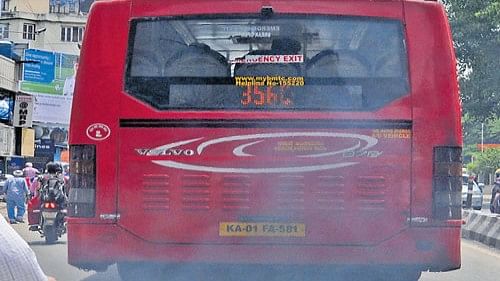
Increasing number of vehicles and respirable suspended particulate matter due to road dust and mud contribute to the high levels of pollution
DH Photo
Bengaluru: As air pollution in the secondary and tertiary cities of Karnataka continues to rise at an alarming rate, a new study has found that the cumulative pollution burden on residents of such cities is up to 300 per cent more, making it necessary to develop new approaches to tackle the problem.
Besides studying pollution caused by vehicle emissions, road dust, industries and other sources in Hubballi-Dharwad, Davanagere and Kalaburagi, the Center for Study of Science, Technology and Policy (CSTEP) looked into the levels of PM 2.5 (micro particles in air associated with various lung diseases, including cancer) in the airshed of each city.
An airshed model looks into a region where the topological and meteorological factors limit the dispersal of pollutant particles. This allows researchers to look into the sources of pollution beyond the administrative and geographical boundaries of the city. This has given new insights into the burden of pollution on residents.
For instance, the CSTEP study found that at the city level, Davanagere had PM 2.5 pollution of 469 tonnes per year compared to Gulbarga's 735 tonnes/year or the 938 tonnes/year recorded in twin cities of Hubballi–Dharwad.
Yet, the 33 km X 34 km airshed within which Davangere is located recorded a whopping 1876 tonnes/year. This was followed by Hubli–Dharwad (1733 tonnes/year) and Gulbarga (1117 tonnes/year).
Apart from PM 2.5, the study looked into the levels of PM 10, sulfur dioxide (SO2), and nitrogen oxides (NOx) in the three cities.
Industries and transportation accounted for SO2 and nitrogen oxides in all the three cities. "By 2030, the city level PM 2.5 emission load is expected to increase by 31%, 38% and 34% under the business-as-usual scenario in Davangere, Kalaburagi and Hubballi-Dharwad, respectively," the study said.
Transportation sector was the primary contributor for PM 2.5 emissions in Hubballi-Dharwad and Kalaburagi while industries were the major polluters for Davangere at the city and airshed levels.
The study stressed the need to adopt the airshed approach to tackle air pollution as limiting the emission sources within the city would lead to underestimation of the pollution levels. For instance, in the Hubballi-Dharwad airshed of 41 kmX38 km, industries located outside the city limits accounted for 74% of PM10, 77% of PM 2.5, 79% SO2 and 73% NOx of the emissions from the sector.
To improve the transportation sector, the study suggested replacing older vehicles, additional public buses, robust pollution-under-control centres, promotion of electric or CNG vehicles, and mechanical sweepers.
Increasing LPG penetration and discouraging solid fuel in the domestic sector, while enforcing the norms issued by the Central Pollution Control Board for industries and implementing solid waste management rules were among the measures suggested by the study to improve air quality.
To implement the prioritised measures in each cities, Rs 738.5 crore was required for Davangere, Rs 582.2 crore was required for Kalaburagi and Rs 968.2 crore was required for Hubballi-Dharwad to reduce PM 2.5 emissions by an average of 33 per cent.